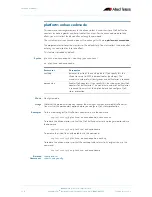
Switching Introduction
©2008 Allied Telesis Inc. All rights reserved.
Software Version 5.2.1
AlliedWare Plus
TM
Operating System Software Reference C613-50003-00 REV E
14.21
Quality of Service
Quality of Service (QoS) enables you to both prioritize traffic and limit its available bandwidth.
The concept of QoS is a departure from the original networking protocols, in which all traffic
on the Internet or within a LAN had the same available bandwidth. Without QoS, all traffic
types are equally likely to be dropped if a link becomes oversubscribed. This approach is now
inadequate in many networks, because traffic levels have increased and networks often carry
time-critical applications such as streams of real-time video data. QoS also enables service
providers to easily supply different customers with different amounts of bandwidth.
Configuring Quality of Service involves two separate stages:
1.
Classifying traffic into flows, according to a wide range of criteria. Classification is
performed by the switch’s class maps.
2.
Acting on these traffic flows.
The switch’s QoS functionality includes the following:
■
policies, to provide a QoS configuration for a port or ports
■
traffic classes, for bandwidth limiting and user prioritization
■
maximum bandwidth limiting on a traffic class
■
flow groups within traffic classes, for user prioritization
■
control of the egress scheduling algorithm
■
priority relabelling of frames, at Layer 2, by replacing the VLAN tag User Priority field
■
class of service relabelling of frames, at Layer 3, by replacing the DSCP (DiffServ Code
Point) or the TOS precedence value in the IP header’s Type of Service (TOS) field.
For more information on QoS see
Chapter 39, Quality of Service (QoS)
and
Chapter 40,
QoS Commands
.















































